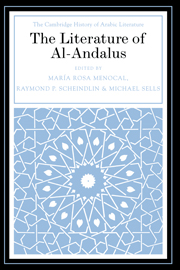3 - Music
from PART I - THE SHAPES OF CULTURE
Published online by Cambridge University Press: 28 May 2012
Summary
Medieval Islamic Spain bequeathed to Europe and the Middle East a rich and enduring heritage in architecture, belles lettres, philosophy, poetry, religious thought, and science. This is no less true in the realm of music. The musical traditions of al-Andalus were celebrated in their own day, influenced the musical traditions of their northern neighbors, eventually relocated to and flourished in North Africa, and also spread to eastern Arab lands where they rapidly took root and thrived. At the easternmost boundaries of the Arabic-speaking world, however, their diffusion stopped; few traces of Andalusian poetic or musical forms are to be found in Persian or Turkish culture.
Along with the Ottoman and Persian classical music traditions, the Arabo-Andalusian musical legacy constitutes one of the great art music traditions of the Middle East, and indeed ranks as one of the oldest continuously performed art music traditions in the world. Arabo-Andalusian music (al-mūsīqā al-andalusiyya) subsumes a variety of historically distinct subtraditions that can be briefly identified as follows.
Iberian: These include the Arab musical traditions that originated in medieval Islamic Spain, specifically, the muwashshah and zajal, the two strophic vocal genres that emerged uniquely in Muslim Spain, and their associated instrumental genres. Although sometimes portrayed as a courtly tradition of the Muslim elite, the medieval song tradition of muwashshahs and zajals extended across sectarian and social boundaries.
- Type
- Chapter
- Information
- The Literature of Al-Andalus , pp. 60 - 82Publisher: Cambridge University PressPrint publication year: 2000
References
- 2
- Cited by



